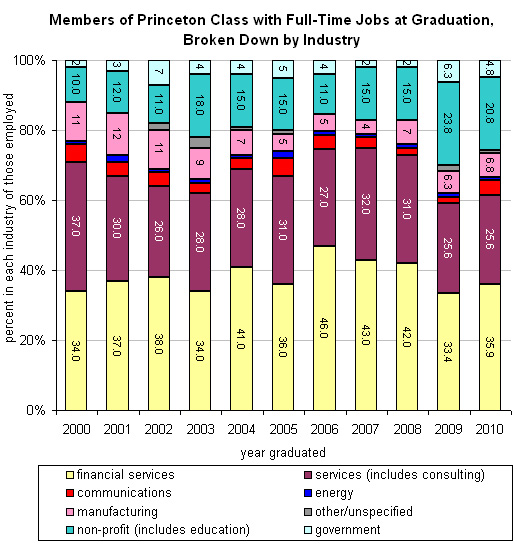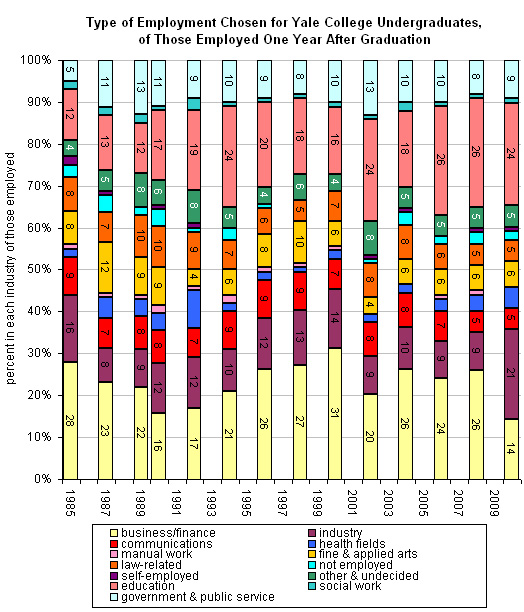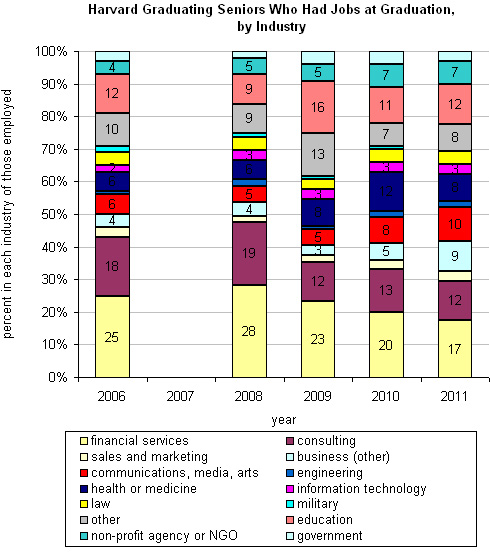11:29 a.m. | Updated to include more detail on Yale’s definition of “industry” employment.
Given the efforts at some of the top schools to guide their students away from Wall Street and into public service, I’ve been wondering whether the career choices of the nation’s young elites have changed much in the last few years.
I’ve gathered some data from three elite schools known for sending a lot of students into finance: Princeton, Yale and Harvard. Each school categorizes the jobs of its graduating seniors in different ways, so we can’t compare them to one another. But we can look at within-school trends to see how student choices are changing over time.
Note: The percentages below refer to students who actually had jobs, and so for the most part exclude students who were unemployed or in graduate school.
Since I’m a proud Tiger, let’s start with Princeton, which sent me data going back to 2000. The share entering finance jobs is in yellow, and I’ve included exact percentages for some of the more popular industries:
 Source: Princeton Office of Career Services.
Source: Princeton Office of Career Services.
Of Princeton seniors who had jobs lined up after graduation, 35.9 percent went into finance in 2010 (the most recent year available). That’s a very large share, but still lower than the peak of 46 percent in 2006.
The steady flow of Princeton students to Wall Street has caused the university some P.R. (and legal) problems in the past, since the school’s motto is, “In the Nation’s Service, and in the Service of All Nations.”
The share of newly minted Princeton grads going into public service jobs — either at nonprofits or in government — was 25.6 percent in 2010. That’s higher than it had been; in 2006, before the recession officially began in December 2007, it was 15 percent.
Now onto Yale, which releases information about where graduates end up a year after commencement.
Yale has numbers going back several decades, and they show that young Bulldogs are weathering the job market just fine. Of all classes Yale has surveyed since 1968, the class of 2010 had the largest percentage of its graduates employed in the first year after college. Despite the weak economy, 75 percent of all members of the class of 2010 had jobs a year after graduation; in 1968, just 20 percent did.
On the flip side, the percentage of Yale college graduates who were engaged in graduate/professional study in the first year after graduation was at its lowest level (21 percent) since the school started keeping track of that number in 1960.
Here are the percent distributions for new Yale grads who were working (or actively looking for work, as opposed to study or other activities) a year after tossing up their mortarboards. The school breaks down its employed students’ career choices into more categories, so I apologize if the multicolored chart below is giving anyone seizures:
 Source: Beverly Waters, Office of Institutional Research, Yale University. June 2011. Note: Industry categories with fewer than 1 percent of employed students are excluded.
Source: Beverly Waters, Office of Institutional Research, Yale University. June 2011. Note: Industry categories with fewer than 1 percent of employed students are excluded.
Of the 2010 graduates who were working a year out, 14 percent were in business/finance jobs, down from a peak of 31 percent in 2000.
However, the share of students going to industry went way up last year. A Yale spokeswoman said this category includes sectors like manufacturing, business/management consulting, sales and marketing, I.T. jobs of all sorts (software engineering, development, sales), engineering and real estate.
Finally, let’s look at Harvard.
When I asked Harvard about career choice data, the school said it could publicly release numbers only for 2006 and for 2008-11. So we have fewer years to examine, but they still seem to tell a story:
 Source: Harvard Office of Career Services.
Source: Harvard Office of Career Services.
Upon graduation, those Harvard grads entering jobs were more likely to enter finance than any other career: in fact, 17 percent of new grads did so. But this share is still significantly lower than it was just a few years ago. In 2008, 28 percent of employed new grads worked in financial services.
The share in consulting has also been trending downward. (As my colleague David Leonhardt wrote a few weeks ago, consulting seems to be losing its cachet amongst newly-minted M.B.A.’s, too.)
Of course, this is but a small sample of top schools, which are in no way representative of the broader job market for 22-year-olds.
Even so, these data are a nice peek at how the financial crisis may be changing elite students’ ambitions.
Article source: http://feeds.nytimes.com/click.phdo?i=86d31bfd28a119a8eb3adbdf38d1aad2
Speak Your Mind
You must be logged in to post a comment.